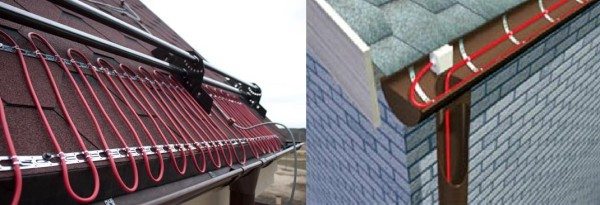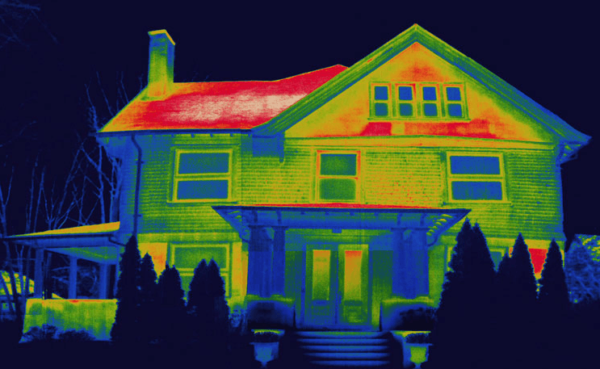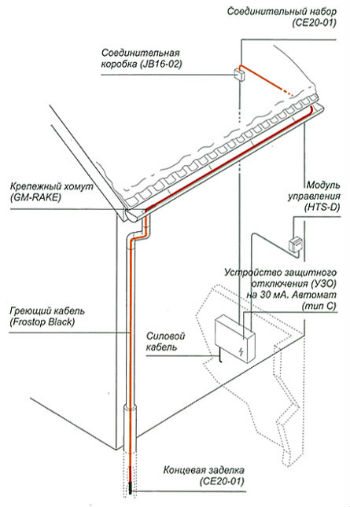The topic of this article is cable heating of gutters.
We will find out what goals he pursues; in addition, we have to get acquainted with the types of equipment that can be used in heating systems.

Why is it needed
The obvious goal is to get rid of ice buildup, to prevent the narrowing of the gap of the drains and the heaviness of the gutters. The overgrown ice is quite capable of completely blocking the outflow of melt water from the roof. The consequences are quite unpleasant: the roof overhang will be decorated with massive icicles, the fall of which does not bode well for either pedestrians or vehicles.
In addition: the fastening of gutters is not designed for a mass of tens or even hundreds of kilograms of ice.
A fall of an ice-filled pipe can also cause a lot of trouble, and the restoration of the drainage system will be quite expensive.
Why do drains and gutters get covered in ice?
There are two reasons:
- In the thaw and off-season, the temperature during the day often fluctuates around zero.. A very typical situation is when snow melts in the sun and immediately freezes in the form of ice on the inner wall of a pipe hung in the shade.
- In addition, the so-called "warm" roofs with residential attics or operated attics below them can cause accumulating snow to melt at temperatures down to -10C. It is clear that a significant part of the melt water will not have time to run down.

Implementation
The heating system for gutters and gutters, quite predictably, is a heating cable and a certain amount of auxiliary equipment. All other methods of heat supply are much more expensive at the stage of installation or operation.
Cable
Let's start with finding out what a heating cable can be: cable heating depends very much on its type both in terms of implementation and in terms of efficiency.
Actually, if you do not go into unprincipled details, then we can distinguish two main types of solutions:
- Resistive.
- Self-adjusting.
What is a resistive cable for heating gutters? Just a conductor with a sufficiently high resistivity in sealed insulation. Since the specific resistance is constant, so is the heat dissipation (of course, at a constant supply voltage).
Minor details may vary:
- There may be one or two current-carrying conductors.
- Additional layers of insulation and protective shells may be present - fluoroplastic, fiberglass, etc.
- Since this type of single-core cable is a fairly powerful source of electromagnetic radiation, it is often equipped with a shielding braid of thin copper wire or an aluminum foil sheath.

The cable, however, has several inherent disadvantages that cannot be eliminated within the framework of the very principle of its operation.
- It is uneconomical. If the drainpipe is only filled with ice at the bottom, the heating of the drain will still be the same along its entire length.
- With a fixed specific resistance of a running meter, to ensure the rated current (and, accordingly, heat dissipation), the conductor must have a strictly defined length. It cannot be shortened or lengthened in any significant way.
- If the cable overlaps, local overheating is possible. The consequence is the destruction of insulation and the burnout of current-carrying wires due to a short circuit.
Please note: if in metal gutter roof the wire will only burn itself out, then in plastic it will most likely also melt the walls.
All these shortcomings are deprived of a self-regulating cable.
How is it arranged?
- Two current-carrying cores have low resistance and are designed for significant current. During operation, they themselves emit almost no heat.
- Between the cores there is a self-regulating matrix itself - an insert made of a polymer with a high coefficient of thermal expansion, saturated with a finely dispersed conductor (usually coal dust).
- From the external environment, the entire structure is protected by hermetic insulation.

Upon cooling, the polymer insert shrinks in size. In this case, the conductor particles approach each other. The resistance drops and the current flowing through the insert increases. The cable section starts to heat up.
When overheating, the process is inverted.
As a result of such an ingenious design, one can not be afraid of overheating; in addition, the cable can be cut into pieces of arbitrary length.
Optional equipment
What other equipment does heating of gutters and gutters require?
- A set of a common RCD and an automaton on each individual circuit insures against a short circuit.
- A thermostat with a remote sensor turns on and off the heating only in a certain temperature range (usually from -8 to +3 C).
Helpful: A more expensive alternative to a thermostat is a weather station that monitors changes in thickness. snow cover on the roof and its melting.
- Automatic circuit breaker for the control circuit of a thermostat or weather station.
- Conventional insulated cables that supply power to gutters.
- Signal cable for connecting a remote outdoor temperature sensor.
- Mounting boxes.
- Sealed cable glands.
- Mounting tape with sealant and rivets.
- With a roof height of more than 6 meters - a metal cable in a protective sheath.

Installation
Installation of heating gutters and gutters, in general, does not present any particular difficulties: a cable with a power density of 20-30 watts / meter is laid in horizontal sections with fixation with a mounting tape; in vertical drains, it simply hangs down inside.
As always, the devil is in the details.
- In the case of a large (from 6 meters) height of the vertical drain, the cable is attached to a metal cable, which is hung inside the pipe. Otherwise, the break becomes too probable.
- In the gutters, the mounting tape is fixed with rivets; then the attachment area for sealing is smeared with sealant. The pitch of the attachment points is 25 cm for resistive and 50 for self-regulating cable.
- Before switching on for the first time, the resistance of the cables must be checked. In this way, you can be safe from short circuits due to damage or installation errors.

Conclusion
The video in this article will offer you a visual description of how you can organize the heating of gutters with your own hands. Good luck!
Did the article help you?
